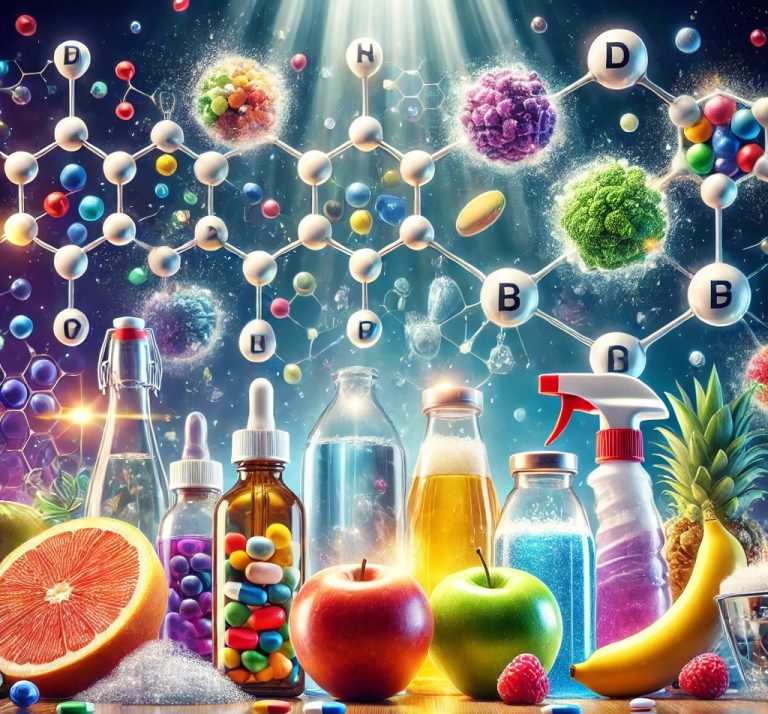Biogas production is a significant process in the renewable energy sector, offering an eco-friendly solution to waste management and energy generation. Biogas, primarily composed of methane (CH₄), is produced through the anaerobic digestion of organic materials. Microorganisms play a crucial role in the production of biogas by breaking down complex organic compounds in the absence of oxygen. The process involves the activity of various types of bacteria, archaea, and other microorganisms that collaborate to convert organic matter, such as agricultural waste, food scraps, and sewage sludge, into biogas. This 2000-word explanation delves into the role of microbes in biogas production, highlighting the types of microorganisms involved, the steps in biogas production, and the significance of this process in sustainable energy production.
What is Biogas?
Biogas is a mixture of gases, primarily methane (50–70%), carbon dioxide (30–50%), and trace amounts of other gases like hydrogen sulfide, ammonia, and nitrogen. It is produced through anaerobic digestion, a biological process where organic matter is decomposed by microorganisms in the absence of oxygen. The primary component, methane, is a valuable energy source, which can be used for electricity generation, heating, and as a fuel for vehicles.
Biogas is produced from various organic waste materials, including:
- Agricultural waste: Crop residues, manure, and other organic by-products.
- Food waste: Leftover food and food scraps.
- Sewage sludge: Organic matter from wastewater treatment plants.
- Industrial organic waste: Organic by-products from food processing, breweries, and other industries.
The production of biogas offers numerous environmental benefits, including waste reduction, decreased greenhouse gas emissions, and a renewable source of energy.
The Role of Microbes in Biogas Production
The anaerobic digestion process relies on the activity of several groups of microorganisms that work together in a highly coordinated manner to break down complex organic compounds into simpler molecules, including methane. Microbes involved in biogas production can be broadly categorized into three groups based on the stages of digestion they are involved in: hydrolytic bacteria, acidogenic bacteria, and methanogenic archaea.
1. Hydrolytic Bacteria
Hydrolytic bacteria are the first group of microorganisms involved in biogas production. These bacteria are responsible for breaking down complex organic matter, such as proteins, fats, and carbohydrates, into simpler molecules such as sugars, fatty acids, and amino acids. This stage is known as hydrolysis, where large organic polymers are converted into smaller, soluble monomers.
- Example microbes: Clostridium, Bacteroides, Ruminococcus.
Hydrolysis is a critical step because most of the organic materials in waste, such as cellulose, starch, and proteins, are insoluble and complex. Hydrolytic bacteria produce enzymes like cellulase and amylase to break down these polymers into simpler compounds, making them available for further microbial degradation.
2. Acidogenic Bacteria
Once the complex organic materials are broken down into simpler compounds, acidogenic bacteria (also called fermentative bacteria) take over the process. These bacteria convert the soluble monomers, such as sugars, amino acids, and fatty acids, into volatile fatty acids (VFAs), alcohols, hydrogen, and carbon dioxide. The process is called acidogenesis.
- Example microbes: Clostridium spp., Bacteroides, Fusobacterium.
Acidogenic bacteria play a vital role in the initial stages of digestion by breaking down complex organic molecules into simpler intermediate compounds that can be used by other bacteria in later stages. This step is crucial because it produces the building blocks for methane generation, such as acetate, hydrogen, and carbon dioxide.
3. Acetogenic Bacteria
Acetogenic bacteria are involved in converting the products of acidogenesis, such as volatile fatty acids (VFAs) and alcohols, into acetate, a key intermediate for methane-producing microorganisms. The process of converting VFAs to acetate is essential because acetoclastic methanogens, which produce methane, primarily use acetate as a substrate.
- Example microbes: Syntrophomonas, Syntrophobacter, Acetobacterium.
Acetogenic bacteria are critical in ensuring the proper conversion of fermentation products into acetate, which can then be used by methanogens to produce methane. This step is particularly important in systems where volatile fatty acid concentrations are high, such as in food waste or high-strength industrial effluents.
4. Methanogenic Archaea
The final step in biogas production is methanogenesis, where methane is produced by a group of archaea known as methanogens. These microorganisms are responsible for converting the intermediate products, primarily acetate, hydrogen, and carbon dioxide, into methane.
Methanogenesis can occur in two main pathways:
- Acetoclastic methanogenesis: In this pathway, acetoclastic methanogens convert acetate into methane and carbon dioxide.
- Hydrogenotrophic methanogenesis: In this pathway, hydrogenotrophic methanogens convert hydrogen and carbon dioxide into methane.
- Example microbes: Methanobacterium, Methanococcus, Methanosarcina.
Methanogens are the key contributors to methane production in biogas digesters. They play a crucial role in stabilizing the anaerobic digestion process by consuming the by-products of acidogenesis and acetogenesis and converting them into methane.
The Stages of Anaerobic Digestion
Anaerobic digestion is a complex, multi-stage process that involves several microbial communities. The process can be broken down into four primary stages:
1. Hydrolysis (Breaking down complex organic compounds)
In the hydrolysis stage, complex organic molecules such as fats, proteins, and carbohydrates are broken down into simpler compounds (monomers) by hydrolytic bacteria. This step is essential because it converts the insoluble organic matter into soluble forms that can be further processed by other microbes.
2. Acidogenesis (Fermentation of simple compounds)
Acidogenic bacteria take over in the acidogenesis stage. These bacteria convert the products of hydrolysis (e.g., sugars, fatty acids, and amino acids) into intermediate compounds, including volatile fatty acids (VFAs), alcohols, hydrogen, and carbon dioxide. These products are necessary for methane production in the subsequent stages.
3. Acetogenesis (Production of acetate)
In this stage, acetogenic bacteria convert VFAs and alcohols into acetate, hydrogen, and carbon dioxide. Acetate is one of the key substrates for methane production, and the conversion of VFAs into acetate is vital for the efficient operation of the digester.
4. Methanogenesis (Production of methane)
The final step in anaerobic digestion is the conversion of acetate, hydrogen, and carbon dioxide into methane by methanogenic archaea. Methane is the primary energy product of biogas, and its production marks the successful completion of anaerobic digestion.
Factors Influencing Microbial Activity in Biogas Production
Several factors influence the efficiency of microbial processes in biogas production. These factors include temperature, pH, substrate composition, and the presence of inhibitors.
1. Temperature
Temperature significantly affects microbial activity in anaerobic digestion. Microbes involved in biogas production have optimal temperature ranges where they perform most efficiently. There are three main temperature ranges:
- Mesophilic conditions: Typically between 30–40°C, mesophilic bacteria are commonly used in biogas production.
- Thermophilic conditions: Between 50–60°C, thermophilic bacteria work at higher temperatures, producing faster biogas but requiring more careful control.
- Psychrophilic conditions: Below 20°C, psychrophilic bacteria are involved in cold-adapted anaerobic digestion.
Maintaining the optimal temperature range is crucial to ensure efficient microbial metabolism and biogas production.
2. pH
The pH of the digester affects the activity of different microbial groups. Most microorganisms involved in biogas production function best in a neutral to slightly acidic pH range (6.5 to 7.5). If the pH falls below 6.5 or rises above 8, it can inhibit microbial activity and reduce biogas production.
3. Substrate Composition
The type of organic matter being digested also influences microbial activity. Materials with high levels of cellulose (like agricultural residues) may require longer hydrolysis times, while materials rich in simple sugars (such as food waste) are more readily digestible by acidogenic bacteria.
4. Presence of Inhibitors
Inhibitors such as ammonia, hydrogen sulfide, and high concentrations of volatile fatty acids can interfere with microbial activity in the digester. Ammonia, for example, can inhibit methanogens and acidogens, leading to reduced biogas production. Proper management of these inhibitors is essential for maintaining a healthy microbial population.
Applications of Biogas
Biogas produced through anaerobic digestion has numerous applications:
- Electricity Generation: Biogas can be burned to generate electricity in combined heat and power (CHP) units, providing renewable energy to homes, farms, and industries.
- Heating: Biogas can be used as a direct fuel for heating, reducing reliance on fossil fuels.
- Vehicle Fuel: With purification and upgrading, biogas can be compressed and used as a vehicle fuel (biomethane).
- Fertilizer: The residual material (digestate) left after anaerobic digestion is rich in nutrients and can be used as an organic fertilizer.
Here are 10 Questions and Answers with Explanations on the topic of Microbes in Biogas Production:
1. What is biogas, and what are its main components?
Answer: Biogas is a mixture of gases produced by the anaerobic digestion of organic matter. Its main components are methane (CH₄), which typically makes up 50–70% of the gas, and carbon dioxide (CO₂), which accounts for 30–50%. It also contains trace gases like hydrogen sulfide (H₂S) and ammonia (NH₃).
Explanation: Methane is the primary energy-rich component of biogas, making it a valuable fuel for electricity generation, heating, and as an alternative to natural gas. Carbon dioxide is a non-combustible gas, and other trace gases need to be removed in some biogas applications to prevent corrosion or other issues.
2. How do microbes contribute to biogas production?
Answer: Microbes are essential in breaking down complex organic materials during anaerobic digestion. Different groups of microorganisms (hydrolytic bacteria, acidogenic bacteria, acetogenic bacteria, and methanogens) work sequentially to degrade organic waste into simpler compounds, ultimately producing methane.
Explanation: Hydrolytic bacteria start by breaking down large organic molecules into smaller ones. Acidogenic bacteria further break these down into intermediate compounds. Acetogenic bacteria convert these intermediates into acetate, hydrogen, and carbon dioxide, which are finally used by methanogens to produce methane. This multi-step microbial process is the core of biogas production.
3. What are hydrolytic bacteria, and what is their role in biogas production?
Answer: Hydrolytic bacteria are microorganisms that break down large, complex organic compounds such as cellulose, proteins, and fats into simpler monomers (sugars, amino acids, and fatty acids) through hydrolysis.
Explanation: The hydrolysis stage is crucial in making the complex organic matter available for further microbial processing. Without hydrolytic bacteria, the initial breakdown of materials like food waste or agricultural residues into simpler forms would not occur, preventing the biogas production process from moving forward.
4. What is the role of acidogenic bacteria in biogas production?
Answer: Acidogenic bacteria are responsible for fermenting the monomers produced by hydrolytic bacteria into volatile fatty acids (VFAs), alcohols, hydrogen, and carbon dioxide.
Explanation: Acidogenesis is an important step that converts simple sugars, amino acids, and fatty acids into intermediate compounds that can be further processed by acetogenic bacteria and methanogens. This step helps in creating the necessary substrates (like acetate and hydrogen) for methane production.
5. What are methanogens, and how do they contribute to biogas production?
Answer: Methanogens are a group of archaea (microorganisms) responsible for the final step in biogas production: converting acetate, hydrogen, and carbon dioxide into methane (CH₄).
Explanation: Methanogenesis is the most critical step in biogas production. Methanogens perform two main processes: acetoclastic methanogenesis (converting acetate into methane) and hydrogenotrophic methanogenesis (converting hydrogen and carbon dioxide into methane). This step produces the primary energy-rich component of biogas, methane.
6. What is the anaerobic digestion process?
Answer: Anaerobic digestion is a biological process where microorganisms break down organic materials in the absence of oxygen, producing biogas (primarily methane) and digestate (a nutrient-rich by-product).
Explanation: The process consists of four main stages: hydrolysis (complex molecules are broken down), acidogenesis (simple compounds are fermented into VFAs and gases), acetogenesis (conversion of VFAs to acetate), and methanogenesis (production of methane by methanogens). Anaerobic digestion is widely used in wastewater treatment, agricultural waste management, and waste-to-energy systems.
7. What factors influence microbial activity in biogas production?
Answer: Several factors affect microbial activity in biogas production, including temperature, pH, substrate composition, and the presence of inhibitors like ammonia and hydrogen sulfide.
Explanation: Microbial activity is highly sensitive to changes in temperature. Most microorganisms involved in biogas production function best in mesophilic (30–40°C) or thermophilic (50–60°C) conditions. pH also affects microbial efficiency, with most microbes thriving in neutral to slightly acidic conditions (pH 6.5–7.5). The composition of organic waste (whether it is high in cellulose, sugars, or fats) influences the time and conditions required for optimal digestion. Additionally, toxic compounds like ammonia or high levels of volatile fatty acids can inhibit microbial activity.
8. What are volatile fatty acids (VFAs), and why are they important in biogas production?
Answer: Volatile fatty acids (VFAs) are intermediate compounds produced during the fermentation of organic material by acidogenic bacteria. They include acetic acid, propionic acid, butyric acid, and others.
Explanation: VFAs are important because they are key substrates for acetogenic bacteria, which convert them into acetate, hydrogen, and carbon dioxide. Acetate is one of the primary substrates for methanogens, leading to methane production. The accumulation of excess VFAs can inhibit the overall digestion process, so controlling their concentration is critical for efficient biogas production.
9. What are the benefits of biogas production from waste?
Answer: Biogas production from organic waste offers several environmental and economic benefits, including waste reduction, renewable energy production, and reduced greenhouse gas emissions.
Explanation: By converting organic waste into biogas, landfills are less reliant on traditional waste disposal methods, which can generate harmful emissions like methane. The methane captured and used as biogas is a renewable energy source, which can help reduce the dependence on fossil fuels. Additionally, the by-product of anaerobic digestion, called digestate, can be used as a nutrient-rich fertilizer.
10. How is biogas used as a renewable energy source?
Answer: Biogas can be used as a renewable energy source for generating electricity, heating, or as a fuel for vehicles (when upgraded to biomethane). It can also be used in combined heat and power (CHP) systems for efficient energy production.
Explanation: The methane in biogas is the primary energy-producing component, which can be burned to generate electricity or heat. In some cases, biogas is purified to remove impurities like carbon dioxide and hydrogen sulfide, upgrading it to biomethane, which can be used in natural gas-powered vehicles. This makes biogas an important component of the transition to renewable energy, especially in areas where organic waste is abundant.






